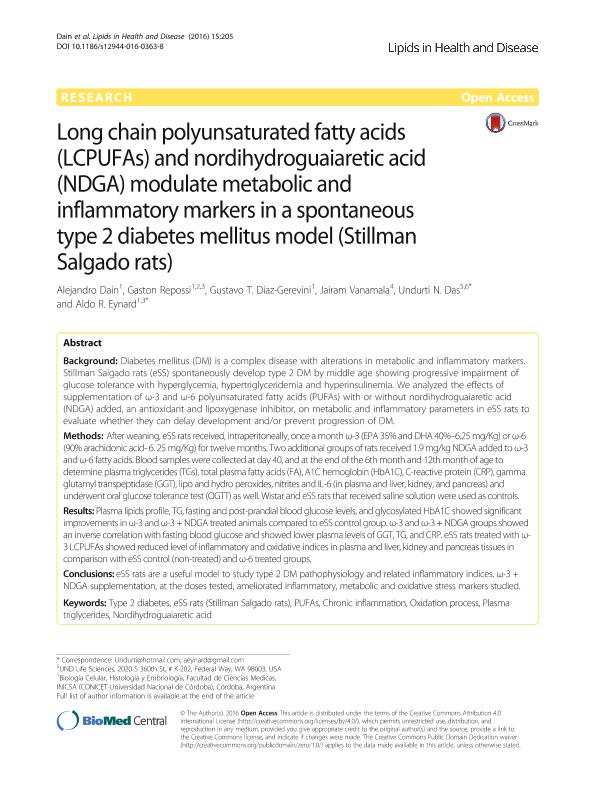Mostrar el registro sencillo del ítem
dc.contributor.author
Dain, Alejandro

dc.contributor.author
Repossi Marquez, Pablo Gaston

dc.contributor.author
Diaz Gerevini, Gustavo T.
dc.contributor.author
Vanamala, Jairam
dc.contributor.author
Das, Undurti N.
dc.contributor.author
Eynard, Aldo Renato

dc.date.available
2018-09-03T14:40:38Z
dc.date.issued
2016-12
dc.identifier.citation
Dain, Alejandro; Repossi Marquez, Pablo Gaston; Diaz Gerevini, Gustavo T.; Vanamala, Jairam; Das, Undurti N.; et al.; Long chain polyunsaturated fatty acids (LCPUFAs) and nordihydroguaiaretic acid (NDGA) modulate metabolic and inflammatory markers in a spontaneous type 2 diabetes mellitus model (Stillman Salgado rats); BioMed Central; Lipids In Health And Disease; 15; 205; 12-2016; 1-15
dc.identifier.issn
1476-511X
dc.identifier.uri
http://hdl.handle.net/11336/58042
dc.description.abstract
Diabetes mellitus (DM) is a complex disease with alterations in metabolic and inflammatory markers. Stillman Salgado rats (eSS) spontaneously develop type 2 DM by middle age showing progressive impairment of glucose tolerance with hyperglycemia, hypertriglyceridemia and hyperinsulinemia. We analyzed the effects of supplementation of ω-3 and ω-6 polyunsaturated fatty acids (PUFAs) with or without nordihydroguaiaretic acid (NDGA) added, an antioxidant and lipoxygenase inhibitor, on metabolic and inflammatory parameters in eSS rats to evaluate whether they can delay development and/or prevent progression of DM. Methods: After weaning, eSS rats received, intraperitoneally, once a month ω-3 (EPA 35% and DHA 40%-6.25 mg/Kg) or ω-6 (90% arachidonic acid- 6. 25 mg/Kg) for twelve months. Two additional groups of rats received 1.9 mg/kg NDGA added to ω-3 and ω-6 fatty acids. Blood samples were collected at day 40, and at the end of the 6th month and 12th month of age to determine plasma triglycerides (TGs), total plasma fatty acids (FA), A1C hemoglobin (HbA1C), C-reactive protein (CRP), gamma glutamyl transpeptidase (GGT), lipo and hydro peroxides, nitrites and IL-6 (in plasma and liver, kidney, and pancreas) and underwent oral glucose tolerance test (OGTT) as well. Wistar and eSS rats that received saline solution were used as controls. Results: Plasma lipids profile, TG, fasting and post-prandial blood glucose levels, and glycosylated HbA1C showed significant improvements in ω-3 and ω-3 + NDGA treated animals compared to eSS control group. ω-3 and ω-3 + NDGA groups showed an inverse correlation with fasting blood glucose and showed lower plasma levels of GGT, TG, and CRP. eSS rats treated with ω-3 LCPUFAs showed reduced level of inflammatory and oxidative indices in plasma and liver, kidney and pancreas tissues in comparison with eSS control (non-treated) and ω-6 treated groups. Conclusions: eSS rats are a useful model to study type 2 DM pathophysiology and related inflammatory indices. ω-3 + NDGA supplementation, at the doses tested, ameliorated inflammatory, metabolic and oxidative stress markers studied.
dc.format
application/pdf
dc.language.iso
eng
dc.publisher
BioMed Central

dc.rights
info:eu-repo/semantics/openAccess
dc.rights.uri
https://creativecommons.org/licenses/by-nc-sa/2.5/ar/
dc.subject
Chronic Inflammation
dc.subject
Ess Rats (Stillman Salgado Rats)
dc.subject
Nordihydroguaiaretic Acid
dc.subject
Oxidation Process
dc.subject
Plasma Triglycerides
dc.subject
Pufas
dc.subject
Type 2 Diabetes
dc.subject.classification
Otras Medicina Básica

dc.subject.classification
Medicina Básica

dc.subject.classification
CIENCIAS MÉDICAS Y DE LA SALUD

dc.title
Long chain polyunsaturated fatty acids (LCPUFAs) and nordihydroguaiaretic acid (NDGA) modulate metabolic and inflammatory markers in a spontaneous type 2 diabetes mellitus model (Stillman Salgado rats)
dc.type
info:eu-repo/semantics/article
dc.type
info:ar-repo/semantics/artículo
dc.type
info:eu-repo/semantics/publishedVersion
dc.date.updated
2018-08-29T18:39:33Z
dc.journal.volume
15
dc.journal.number
205
dc.journal.pagination
1-15
dc.journal.pais
Reino Unido

dc.journal.ciudad
Londres
dc.description.fil
Fil: Dain, Alejandro. Universidad Nacional de Córdoba. Facultad de Medicina. Cátedra de Histología,embriología y Genética I; Argentina
dc.description.fil
Fil: Repossi Marquez, Pablo Gaston. Consejo Nacional de Investigaciones Científicas y Técnicas. Centro Científico Tecnológico Conicet - Córdoba. Instituto de Investigaciones en Ciencias de la Salud. Universidad Nacional de Córdoba. Instituto de Investigaciones en Ciencias de la Salud; Argentina
dc.description.fil
Fil: Diaz Gerevini, Gustavo T.. Universidad Nacional de Córdoba. Facultad de Medicina. Cátedra de Histología,embriología y Genética I; Argentina. Consejo Nacional de Investigaciones Científicas y Técnicas. Centro Científico Tecnológico Conicet - Córdoba. Instituto de Investigaciones en Ciencias de la Salud. Universidad Nacional de Córdoba. Instituto de Investigaciones en Ciencias de la Salud; Argentina
dc.description.fil
Fil: Vanamala, Jairam. State University of Pennsylvania; Estados Unidos
dc.description.fil
Fil: Das, Undurti N.. Gayatri Vidya Parishad Institue of Health Care and Medical Technology; India
dc.description.fil
Fil: Eynard, Aldo Renato. Consejo Nacional de Investigaciones Científicas y Técnicas. Centro Científico Tecnológico Conicet - Córdoba. Instituto de Investigaciones en Ciencias de la Salud. Universidad Nacional de Córdoba. Instituto de Investigaciones en Ciencias de la Salud; Argentina
dc.journal.title
Lipids In Health And Disease

dc.relation.alternativeid
info:eu-repo/semantics/altIdentifier/doi/http://dx.doi.org/10.1186/s12944-016-0363-8
dc.relation.alternativeid
info:eu-repo/semantics/altIdentifier/url/https://lipidworld.biomedcentral.com/articles/10.1186/s12944-016-0363-8
Archivos asociados
